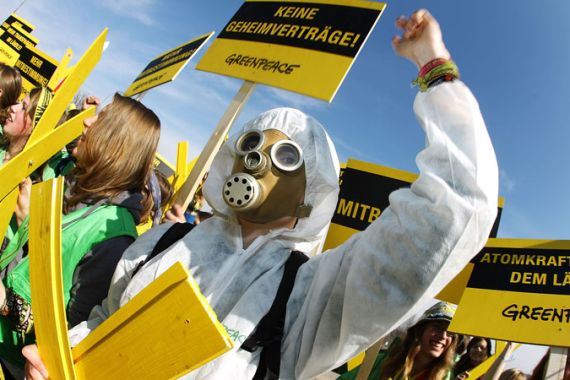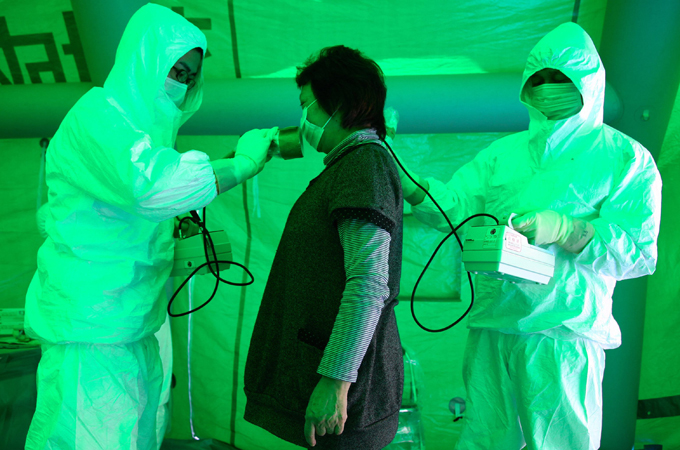‘Stop the nuclear renaissance’
Japan’s nuclear crisis sparked by earthquake is only latest in long line of nuclear accidents across world.

 |
| “If 10 million people were exposed to radiation from a complete nuclear meltdown, about 100,000 would die from acute radiation sickness within six weeks” [REUTERS] |
Japan’s nuclear crisis is a nightmare, but it is not an anomaly.
In fact, it is only the latest in a long line of nuclear accidents involving meltdowns, explosions, fires, and loss of coolant – accidents that have occurred during both normal operation and emergency conditions, such as droughts and earthquakes.
Keep reading
list of 4 itemsAfter the Hurricane
World’s coral reefs face global bleaching crisis
Why is Germany maintaining economic ties with China?
Nuclear safety demands clarity about terms. The Nuclear Regulatory Commission in the United States generally separates unplanned nuclear “events” into two classes, “incidents” and “accidents”.
Incidents are unforeseen events and technical failures that occur during normal plant operation and result in no off-site releases of radiation or severe damage to equipment. Accidents refer to either off-site releases of radiation or severe damage to plant equipment.
The International Nuclear and Radiological Event Scale uses a seven-level ranking scheme to rate the significance of nuclear and radiological events: levels 1-3 are “incidents”, and 4-7 are “accidents”, with a “Level 7 Major Accident” consisting of “a major release of radioactive material with widespread health and environmental effects requiring implementation of planned and extended countermeasures.”
Under these classifications, the number of nuclear accidents, even including the meltdowns at Fukushima Daiichi and Fukushima Daini, is low. But if one redefines an accident to include incidents that either resulted in the loss of human life or more than $50,000 in property damage, a very different picture emerges.
At least 99 nuclear accidents meeting this definition, totaling more than $20.5 billion in damages, occurred worldwide from 1952 to 2009 – or more than one incident and $330 million in damage every year, on average, for the past three decades. And, of course, this average does not include the Fukushima catastrophe.
Indeed, when compared to other energy sources, nuclear power ranks higher than oil, coal, and natural gas systems in terms of fatalities, second only to hydroelectric dams. There have been 57 accidents since the Chernobyl disaster in 1986. While only a few involved fatalities, those that did collectively killed more people than have died in commercial US airline accidents since 1982.
Another index of nuclear-power accidents – this one including costs beyond death and property damage, such as injured or irradiated workers and malfunctions that did not result in shutdowns or leaks – documented 956 incidents from 1942 to 2007. And yet another documented more than 30,000 mishaps at US nuclear-power plants alone, many with the potential to have caused serious meltdowns, between the 1979 accident at Three Mile Island in Pennsylvania and 2009.
Mistakes are not limited to reactor sites. Accidents at the Savannah River reprocessing plant released ten times as much radioiodine as the accident at Three Mile Island, and a fire at the Gulf United facility in New York in 1972 scattered an undisclosed amount of plutonium, forcing the plant to shut down permanently.
At the Mayak Industrial Reprocessing Complex in Russia’s southern Urals, a storage tank holding nitrate acetate salts exploded in 1957, releasing a massive amount of radioactive material over 20,000 square kilometers, forcing the evacuation of 272,000 people. In September 1994, an explosion at Indonesia’s Serpong research reactor was triggered by the ignition of methane gas that had seeped from a storage room and exploded when a worker lit a cigarette.
Accidents have also occurred when nuclear reactors are shut down for refueling or to move spent nuclear fuel into storage. In 1999, operators loading spent fuel into dry-storage at the Trojan Reactor in Oregon found that the protective zinc-carbon coating had started to produce hydrogen, which caused a small explosion.
Unfortunately, on-site accidents at nuclear reactors and fuel facilities are not the only cause of concern. The August 2003 blackout in the northeastern US revealed that more than a dozen nuclear reactors in the US and Canada were not properly maintaining backup diesel generators. In Ontario during the blackout, reactors designed to unlink from the grid automatically and remain in standby mode instead went into full shutdown, with only two of twelve reactors behaving as expected.
As environmental lawyers Richard Webster and Julie LeMense argued in 2008, “the nuclear industry…is like the financial industry was prior to the crisis” that erupted that year. “[T]here are many risks that are not being properly managed or regulated.”
This state of affairs is worrying, to say the least, given the severity of harm that a single serious accident can cause. The meltdown of a 500-megawatt reactor located 30 miles from a city would cause the immediate death of an estimated 45,000 people, injure roughly another 70,000, and cause $17 billion in property damage.
A successful attack or accident at the Indian Point power plant near New York City, apparently part of Al Qaeda’s original plan for September 11, 2001, would have resulted in 43,700 immediate fatalities and 518,000 cancer deaths, with cleanup costs reaching $2 trillion.
To put a serious accident in context, according to data from my forthcoming book Contesting the Future of Nuclear Power, if 10 million people were exposed to radiation from a complete nuclear meltdown (the containment structures fail completely, exposing the inner reactor core to air), about 100,000 would die from acute radiation sickness within six weeks. About 50,000 would experience acute breathlessness, and 240,000 would develop acute hypothyroidism. About 350,000 males would be temporarily sterile, 100,000 women would stop menstruating, and 100,000 children would be born with cognitive deficiencies. There would be thousands of spontaneous abortions and more than 300,000 later cancers.
Advocates of nuclear energy have made considerable political headway around the world in recent years, touting it as a safe, clean, and reliable alternative to fossil fuels. But the historical record clearly shows otherwise. Perhaps the unfolding tragedy in Japan will finally be enough to stop the nuclear renaissance from materialising.
Benjamin K. Sovacool, a professor at the Lee Kuan Yew School of Public Policy, National University of Singapore, is the author of Contesting the Future of Nuclear Power and co-author of the forthcoming The International Politics of Nuclear Power.
This article was first published by Project Syndicate.
The views expressed in this article are the author’s own and do not necessarily reflect Al Jazeera’s editorial policy.
